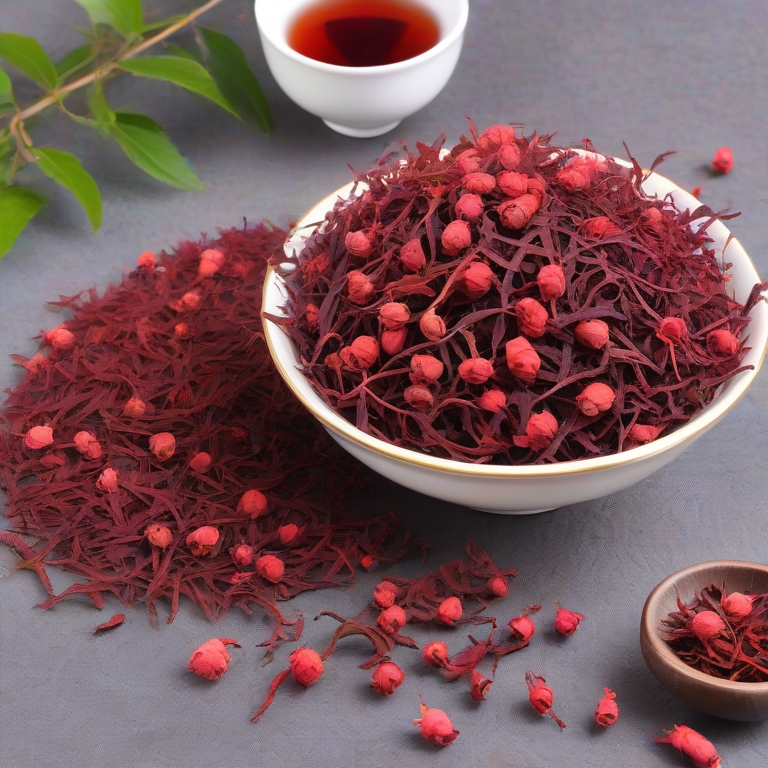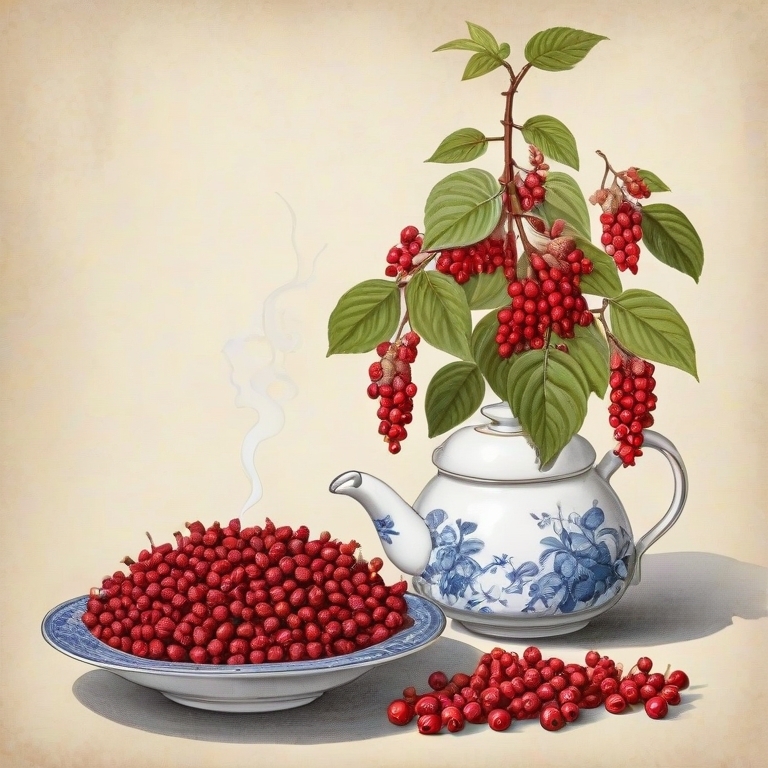Schisandra Fruit (Wu Wei Zi):, Science-Backed Herb You’re Not Hearing Enough About — But Should Be
Posted by 1st Chinese Herbal Review Tea on Nov 24th 2025
Schisandra Fruit (Wu Wei Zi): Science-Backed Herb You’re Not Hearing Enough About — But Should Be
Schisandra fruit—also known as Wu Wei Zi, the “Five-Flavor Berry”—has been a cornerstone of Chinese herbalism for more than 2,000 years. Yet most modern articles barely skim the surface of why this berry has become one of the most respected adaptogens in the world. Today, consumers want more than generic claims… they want proof, clarity, safety, tradition, science, and real-life usefulness.
This is the guide that finally delivers.
Here, we explain what Schisandra really does, why it works, what the research says, who it’s traditionally used for, how to prepare it, and how to know whether Schisandra fruit, powder, or extract is best for you.

What Is Schisandra Fruit (Wu Wei Zi)?
Schisandra (Schisandra chinensis) is the bright red berry known as the Five-Flavor Fruit because it contains all five flavor profiles in TCM: sour, sweet, pungent, bitter, and salty. This makes it one of the most well-balanced herbs in the Chinese Materia Medica.
TCM Category: Astringent herbs
Meridians Entered: Heart, Kidney, Lung
Energetics: Warm, astringent, stabilizing
Schisandra is traditionally used to support the Shen (spirit), strengthen Qi, protect the Liver, and help the body adapt to stress. Modern research often classifies it as an adaptogen.
Schisandra Fruit Benefits
✔ Supports the body’s natural stress response
Schisandra is traditionally used to help the body maintain balance during physical or emotional challenges.
✔ Supports healthy liver function
Used for centuries to support the body’s natural liver processes.
✔ Supports mental focus and clarity
Classically used to calm the spirit while supporting clear thinking.
✔ Helps maintain normal respiratory function
Used in formulas to support the Lungs and normal breathing patterns.
✔ Traditionally used to support healthy sleep patterns
A Shen-calming astringent herb valued for nighttime rest.
✔ Supports healthy energy and vitality
In TCM, Schisandra helps strengthen Kidney Qi and Jing.
Why Schisandra Works (TCM + Modern Perspective)
Traditional Chinese Medicine Theory
Schisandra “gathers and collects” Qi.
It stabilizes and nourishes the:
-
Heart Qi → calmer spirit
-
Lung Qi → stronger breath
-
Kidney Qi → core energy + Jing support
Its astringent nature helps the body preserve what is leaking, whether energy, fluids, or vitality.
Modern Research Perspective
Modern herbalists consider Schisandra an adaptogen, meaning it helps the body maintain balance and respond to external stressors.
Studies suggest Schisandra supports:
-
cellular protection
-
normal liver enzyme function
-
stress response
-
mental clarity
 How to Use Schisandra Fruit
How to Use Schisandra Fruit
Common forms:
-
Whole berries
-
Powder
-
5:1 or 10:1 extract powder
-
Tincture
-
Tea decoction
Tea (Decoction)
Simmer 6–12g dried berries for 20–30 minutes.
Strain and drink warm.
Powder
Use 1–2g daily in warm water or smoothies.
Extract Powder (5:1 or 10:1)
Use ¼–½ teaspoon 1–2 times daily.
Which Form Should You Choose? (Consumer Guide)
| Form | Best For | How It’s Used | Pros |
|---|---|---|---|
| Whole Berries | Traditional tea drinkers | Decoctions | Classic method, deep flavor |
| Powder | Daily wellness | Smoothies, warm water | Easy to use |
| Extract Powder | Stronger potency | 1/4 – 1/2 tsp | Fast, concentrated |
| Capsules (DIY) | Convenience | Use your own capsule maker | Easy travel option |
Frequently Searched Questions
Does Schisandra help with stress?
Traditionally used to support the body’s natural stress response.
Is Schisandra safe to take daily?
Generally used long-term in TCM, but check with a professional if you take medications.
Does Schisandra help the liver?
Used in TCM to support normal liver function.
Can you combine Schisandra with other herbs?
Yes — it’s commonly combined with Ginseng, Astragalus, Reishi, and Goji.
What does Schisandra taste like?
Sweet, salty, sour, pungent, and bitter all at once — the reason it's called the “Five-Flavor Berry.”
Cautions
-
Avoid during acute illness unless directed by a professional.
-
Consult with a practitioner if pregnant, nursing, or taking medications.
-
Stop use if you experience discomfort.
-
Antioxidant Effects of Schisandra chinensis Fruits and Their Active Constituents by Kopustinskiene & Bernatoniene (2021) – Found that extracts from schisandra fruits have potent antioxidant and mitochondria-protecting effects. PubMed
-
Use this to support claims around “antioxidant,” “anti-aging,” “cellular protection.”
-
Example text: “A 2021 review found S. chinensis fruit extracts act as strong antioxidants and mitoprotectors in normal and pathological states.” PubMed
-
-
An analysis of the nutritional effects of Schisandra chinensis (2023) – Reviews its nutritional profile: flavonoids, phenolic acids, anthocyanins, lignans; and functional effects such as immunity, antioxidant, anti-anxiety. PMC
-
Use this to support claims around “nutrient-rich,” “immune support,” “adaptogen effects.”
-
-
Schisandra chinensis fruit modulates the gut microbiota composition in association with metabolic markers in obese women (2015) – A human randomized, double-blind, placebo-controlled study showing schisandra fruit’s influence on gut microbiota and metabolic markers in obese women. PubMed
-
Use this to support claims about metabolism, gut health, weight-management adjunct.
-
-
Improvement of liver function in humans using a mixture of schisandra fruit extract and sesamin (2013) – Shows improvements in liver-enzyme levels (ALT/AST) and antioxidant status in humans taking schisandra fruit extract + sesamin. PubMed
-
Use this to support claims about liver health, detox support.
-
-
Anti‑inflammatory Effects of Schisandra chinensis (Turcz.) Baill. ethanol extract (2014) – Demonstrated anti-inflammatory effects of schisandra extract. PMC
-
Use for claims about “reducing inflammation,” “supporting immune system.”
-
-
A comprehensive review of Schisandra chinensis lignans: pharmacokinetics, pharmacological mechanisms, and future prospects in disease prevention and treatment (2025) – A very recent review focusing on the lignans (active compounds) in schisandra, covering antioxidant, anti-inflammatory, neuroprotective, metabolic, hepatoprotective properties. PubMed

